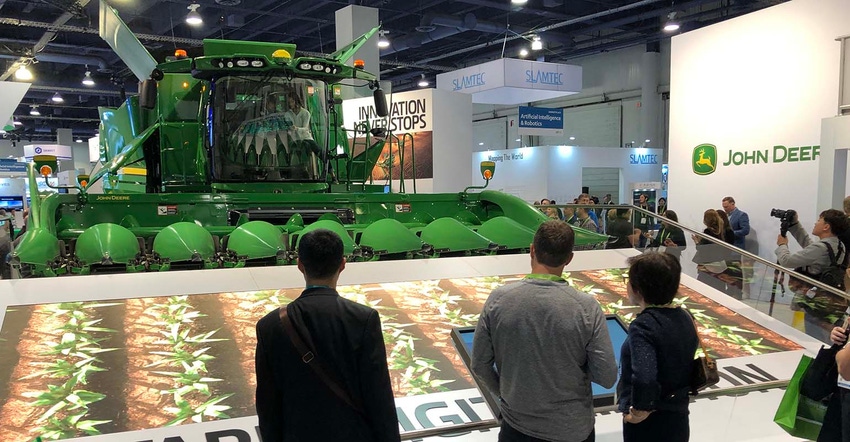January 23, 2019

The display was a standout. The largest single piece of equipment graced the south hall of the Las Vegas Convention Center. The 20-tons of high-tech steel on hand was also a surprise for many of the visitors to the 2019 CES – formerly known as the Consumer Electronics Show. It’s not every day that a tech wonk roaming the halls of this massive event see a combine.
But the big green combine was there for a reason. To show the linkage between modern technology and food production. John Deere was showing off its work to bring new tech to the industry; but also to show existing technology farmers today almost take for granted. To be sure the tech visitors to the exhibit weren’t taking it for granted, many were totally unaware of the level of innovation currently deployed in this industry.
Perhaps the best question – and I’m sure there were hundreds – came from one visitor to the exhibit who asked: “Is this for earth?” The answer, from an astute Deere team member: “Yes, it’s terrestrial.”
Deere was parked in the South Hall where drones, robots and artificial intelligence tech were on display. Visitors got a look at the next-phase high-tech video showing a further future of ag tech, including some very advanced tech.
But the exhibit offered people the opportunity to climb into the cab of the combine and check out the tools farmers rely on today to get crops out of the field. The exhibit had other tech on display too, including the See and Spray system from Blue River, the ultra-precise sprayer we’ve written about before. It’s a clear example of machine learning and artificial intelligence at work in agriculture.
Deere investing in telling this tech story for agriculture moves the conversation beyond our industry to educated folks who are looking to the future. For all the attention to smart kitchens and new kinds of food, there’s really little knowledge in this group of where their meals originate. The tools you use every day remain a mystery.
Further evidence was at the media-only ride-and-drive area where Deere had a tractor running a proscribed route through a parking lot while an employee explained the tech. The most-asked question was “Is this coming to market for 2019?” and the answer was, “No, it was introduced 15 years ago.”
Sharing the story
I feel a little fear when I hear those questions, knowing that the mountain our industry must climb to explain modern food production to an unknowing public seems to get only higher. And also knowing, that there are others filling that gap in knowledge with a fair share of misinformation.
Farmers are leading the charge of using new tools to be more efficient, to better manage resources and increasingly to ratchet up their productivity game. But these tools also help with sustainability, making sure we eek out the most bushels per acre using the fewest inputs. It’s a story we have to keep telling, and frankly it’s one that has to be told in unlikely places.
The packed halls of CES 2019 was a bucket-list item for me; I’m still sorting through piles of information for future stories to share. But being in the John Deere booth (a comfortable, familiar environment for this agnerd) offered a little bit of pride too. Our industry is as cutting edge as anything you see elsewhere. Major companies are looking our way with new ideas that we can deploy, and the savvy ones know that agriculture is ready to take on new tech perhaps faster than most other industries.
My answer: Keep up the good work. Keep your eyes open for new tools that will help you be more efficient. And keep telling the story of modern agriculture to anyone who will listen.
About the Author(s)
You May Also Like






